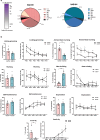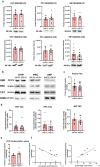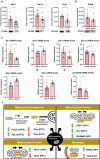Early Handling Exerts Anxiolytic Effects and Alters Brain Mitochondrial Dynamics in Adult High Anxiety Mice
- PMID: 38761326
- PMCID: PMC11584496
- DOI: 10.1007/s12035-024-04116-5
Early Handling Exerts Anxiolytic Effects and Alters Brain Mitochondrial Dynamics in Adult High Anxiety Mice
Abstract
Early handling (EH), the brief separation of pups from their mother during early life, has been shown to exert beneficial effects. However, the impact of EH in a high anxiety background as well as the role of brain mitochondria in shaping EH-driven responses remain elusive.Here, we used a high (HAB) vs. normal (NAB) anxiety-related behavior mouse model to study how EH affects pup and dam behavior in divergent anxiety backgrounds. We also investigated EH-induced effects at the protein and mRNA levels in adult male HAB mice in the hypothalamus, the prefrontal cortex, and the hippocampus by examining the same mitochondrial/energy pathways and mitochondrial dynamics mechanisms (fission, fusion, biogenesis, and mitophagy) in all three brain regions.EH exerts anxiolytic effects in adult HAB but not NAB male mice and does not affect HAB or NAB maternal behavior, although basal HAB vs. NAB maternal behaviors differ. In adult HAB male mice, EH does not impact oxidative phosphorylation (OXPHOS) and oxidative stress in any of the brain regions studied but leads to increased protein expression of glycolysis enzymes and a correlation of anxiety-related behavior with Krebs cycle enzymes in HAB mice in the hypothalamus. Intriguingly, EH alters mitochondrial dynamics by increasing hypothalamic DRP1, OPA1, and PGC1a protein levels. At the mRNA level, we observe altered, EH-driven mitochondrial dynamics mRNA signatures which predominantly affect the prefrontal cortex.Taken together, our results show that EH exerts anxiolytic effects in adulthood in high anxiety and modulates mitochondrial dynamics pathways in a brain region-specific manner.
Keywords: Early life; HAB; Maternal behavior; Mitochondria; Neonatal handling; Post-natal handling.
© 2024. The Author(s).
Conflict of interest statement
Declarations. Ethics Approval: Animal work was carried out in accordance with the European Communities Council Directives 2010/63/EU and approved by the local authorities. Consent to Participate: Not applicable. Consent for Publication: Not applicable. Competing Interests: The authors declare no competing interests.
Figures






Similar articles
-
Early Life Stress Induces Brain Mitochondrial Dynamics Changes and Sex-Specific Adverse Effects in Adulthood.J Neurosci Res. 2025 Apr;103(4):e70023. doi: 10.1002/jnr.70023. J Neurosci Res. 2025. PMID: 40195806
-
Selective Mitochondrial Targeting Exerts Anxiolytic Effects In Vivo.Neuropsychopharmacology. 2016 Jun;41(7):1751-8. doi: 10.1038/npp.2015.341. Epub 2015 Nov 16. Neuropsychopharmacology. 2016. PMID: 26567514 Free PMC article.
-
Maternal care differs in mice bred for high vs. low trait anxiety: impact of brain vasopressin and cross-fostering.Soc Neurosci. 2011;6(2):156-68. doi: 10.1080/17470919.2010.495567. Epub 2010 Jul 21. Soc Neurosci. 2011. PMID: 20661836
-
Candidate genes of anxiety-related behavior in HAB/LAB rats and mice: focus on vasopressin and glyoxalase-I.Neurosci Biobehav Rev. 2007;31(1):89-102. doi: 10.1016/j.neubiorev.2006.07.003. Epub 2006 Aug 28. Neurosci Biobehav Rev. 2007. PMID: 16934871 Review.
-
Maternal nurturing is dependent on her innate anxiety: the behavioral roles of brain oxytocin and vasopressin.Horm Behav. 2011 Feb;59(2):202-12. doi: 10.1016/j.yhbeh.2010.11.012. Epub 2010 Nov 20. Horm Behav. 2011. PMID: 21094649 Review.
Cited by
-
Liquid Chromatography-Tandem Mass Spectrometry Method Development and Validation for the Determination of a New Mitochondrial Antioxidant in Mouse Liver and Cerebellum, Employing Advanced Chemometrics.Molecules. 2025 Apr 24;30(9):1900. doi: 10.3390/molecules30091900. Molecules. 2025. PMID: 40363707 Free PMC article.
References
-
- Patchev AV, Rodrigues AJ, Sousa N, Spengler D, Almeida OF (2014) The future is now: early life events preset adult behaviour. Acta Physiol (Oxf) 210:46–57. 10.1111/apha.12140 - PubMed
-
- Levine S (1957) Infantile experience and resistance to physiological stress. Science 126:405. 10.1126/science.126.3270.405 - PubMed
-
- Kiosterakis G, Stamatakis A, Diamantopoulou A, Fameli M, Stylianopoulou F (2009) Long-term effects of neonatal handling on mu-opioid receptor levels in the brain of the offspring. Dev Psychobiol 51:439–449. 10.1002/dev.20383 - PubMed
MeSH terms
Substances
Grants and funding
LinkOut - more resources
Full Text Sources
Medical
Miscellaneous

